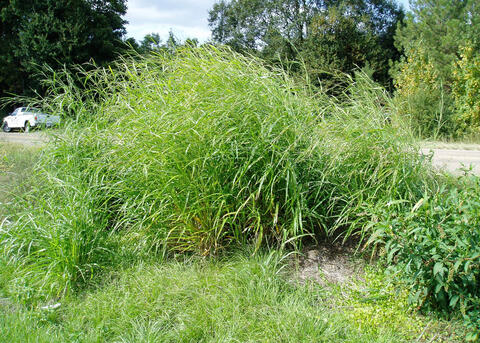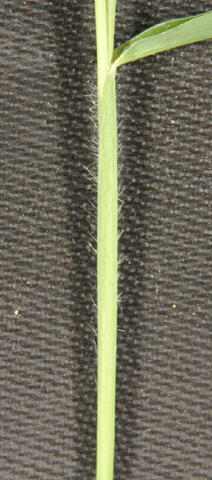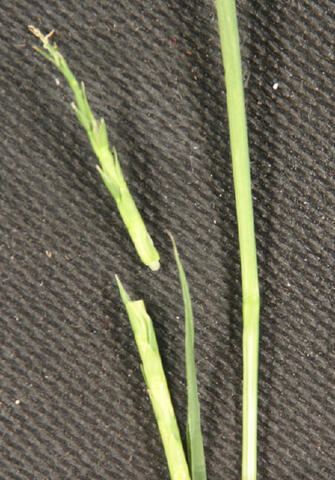P3186
Itchgrass [Rottboellia chochinchinensis (Lour.) W.D. Clayton]

Itchgrass [Rottboellia chochinchinensis (Lour.) W.D. Clayton] is a nonnative, warm-season, annual grass introduced to Miami, Florida, in the 1920s. It is a federal noxious weed and is listed as a state noxious weed in 12 states including Mississippi, Arkansas, Florida, and Texas. Itchgrass is a profusely tillering grass that can be very competitive in row crops and pastures as well as along roadsides (Figure 1). It is spread primarily by seed. Itchgrass germinates in summer, with new plants emerging for extended periods.
Description
Vegetative Growth
Some texts indicate potentially 4 species of Rottboellia L.f., but through recent taxonomic revision, that number is probably closer to 2 or 3. Itchgrass can reach 10 feet or more in height and tillers profusely. Itchgrass has short, stiff hairs on the sheaths (Figure 2), especially near the collar. These hairs can puncture or irritate skin when handled—hence the name itchgrass. The flat leaves are around 1 inch wide, taper to a point, and have short hairs on the leaf surface.
Flowering
The inflorescence is a raceme approximately 4 inches long, with spikelets in pairs and no awns (Figure 3). One of each spikelet is stalked and sterile; the other is stalkless and fertile. Each is attached to a thickened axis. The fertile, stalkless spikelet is oblong and around ¼ inch long. Plant growth is extremely rapid under good conditions, with seed production initiated 6 to 7 weeks after emergence. Seed production continues throughout the growing season. Seeds break off as they mature, but during the after-ripening process, they require a 5- to 6-month period for germination. Seeds may retain viability in the soil for up to 4 years.


Dispersal
Since itchgrass often frequents rights-of-way, the most probable mechanism of dispersal is movement on maintenance equipment, such as mowers. It may also occur in other managed habitats, such as pastures and row crops.
Habitat
Itchgrass is a problem weed in row crops, especially grass crops and pastures, and in railroad, highway, and other rights-of-way (Figure 1).
Distribution
Roettboellia is not native to the United States. Itchgrass is native to the Old World tropics, probably India. It is now widespread in the tropics and subtropics worldwide. It was introduced into the United States for potential forage in the 1920s. Since that time, the grass has been reported in Alabama, Arkansas, Florida, Georgia, Indiana, Louisiana, Mississippi, North Carolina, and Texas. Field studies indicate that itchgrass may grow and produce seed as far north as Minnesota. Despite efforts to map and monitor its spread, the full extent of its invasion is not clear.
Control Methods
There are no effective biological control methods; however, chemical and mechanical methods can be used.
Chemical
Several herbicides can be used for itchgrass pre-emergence and post-emergence control (Tables 1a and 1b). Pre-emergence herbicide options include clomazone + diuron or metribuzin, and pendimethalin. Post-emergence herbicide options include asulam, glyphosate, nicosulfuron, glufosinate, clethodim, fluazifop, quizalofop, sethoxydim, sulfometuron, and trifloxysulfuron + asulam. See Tables 1a and 1b for trade names and rates.
Mechanical
Cultivation has been used to control itchgrass in row crops, although the addition of chemical controls may greatly enhance results in row-cropping systems. Small patches of itchgrass may be removed by hand. Take precautions to avoid the stiff hairs, which may irritate or pierce the skin.
|
Method |
Herbicide |
Rate (ounces per acre or spot treatment) |
|
clomazone + diuron |
Command 3ME + Diuron, Direx, etc., 4L |
32–43 oz/A + 80 oz/A |
|
clomazone + metribuzin |
Command 3ME + Sencor, Metribuzin, etc., 4L |
32–43 oz/A + 24 oz/A |
|
pendimethalin |
Pendulum 3.3EC, Prowl H2O, Prowl 3.3EC, etc. |
19–58 oz/A |
|
Method |
Herbicide |
Rate (ounces per acre or spot treatment) |
|
asulam |
Asulox, Asulam, etc. |
128 oz/A |
|
glyphosate |
Roundup, etc. |
32 oz/A of 3 lb ae/gal formulation |
|
nicosulfuron |
Accent |
0.67 oz/A |
|
glufosinate |
Liberty, Finale, Lifeline, etc. |
28–34 oz/A |
|
clethodim |
Select |
6–16 oz/A or 0.5% |
|
clethodim |
Envoy |
12–32 oz/A or 1% |
|
fluazifop |
Fusilade II |
6–12 oz/A or 0.5% |
|
sethoxydim |
Poast |
12–40 oz/A or 1% |
|
sethoxydim |
Vantage, Poast Plus, Sethoxydim, etc. |
24–36 oz/A or 1.5% |
|
sulfometuron |
Oust, SMS, etc. |
4 oz/A |
|
trifloxysulfuron + asulam |
Envoke, Monument + Asulox, Asulam, etc. |
0.2 oz/A + 96 oz/A |
Reference
USDA, NRCS. 2007. The PLANTS Database. National Plant Data Center, Baton Rouge, LA 70874-4490 USA. http://plants.usda.gov
Publication 3186 (POD-02-24)
By John D. Byrd Jr., PhD, Extension/Research Professor, Plant and Soil Sciences; Victor Maddox, PhD, Senior Research Associate, Plant and Soil Sciences; and Randy Westbrooks, PhD, former Invasive Species Specialist, U.S. Geological Survey.
The Mississippi State University Extension Service is working to ensure all web content is accessible to all users. If you need assistance accessing any of our content, please email the webteam or call 662-325-2262.
